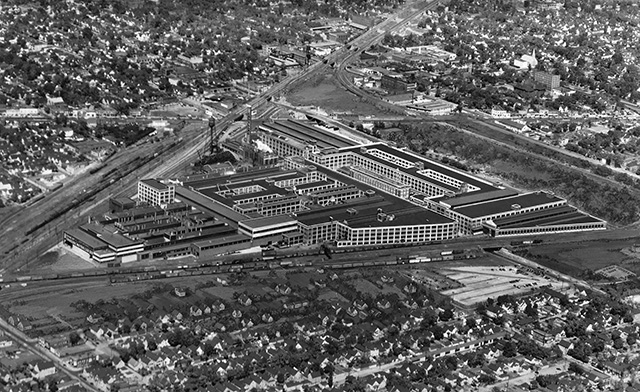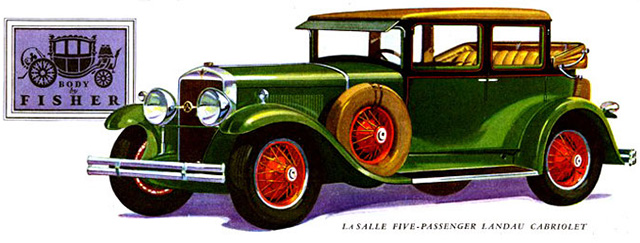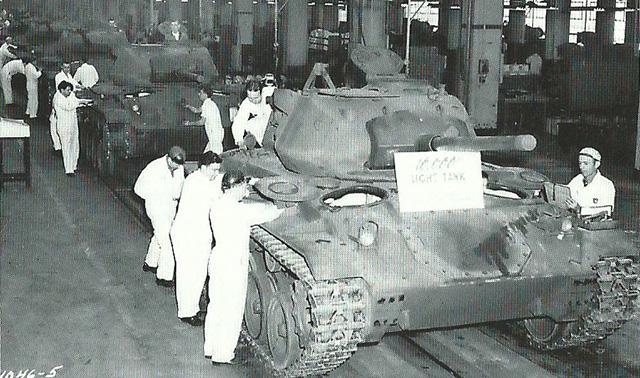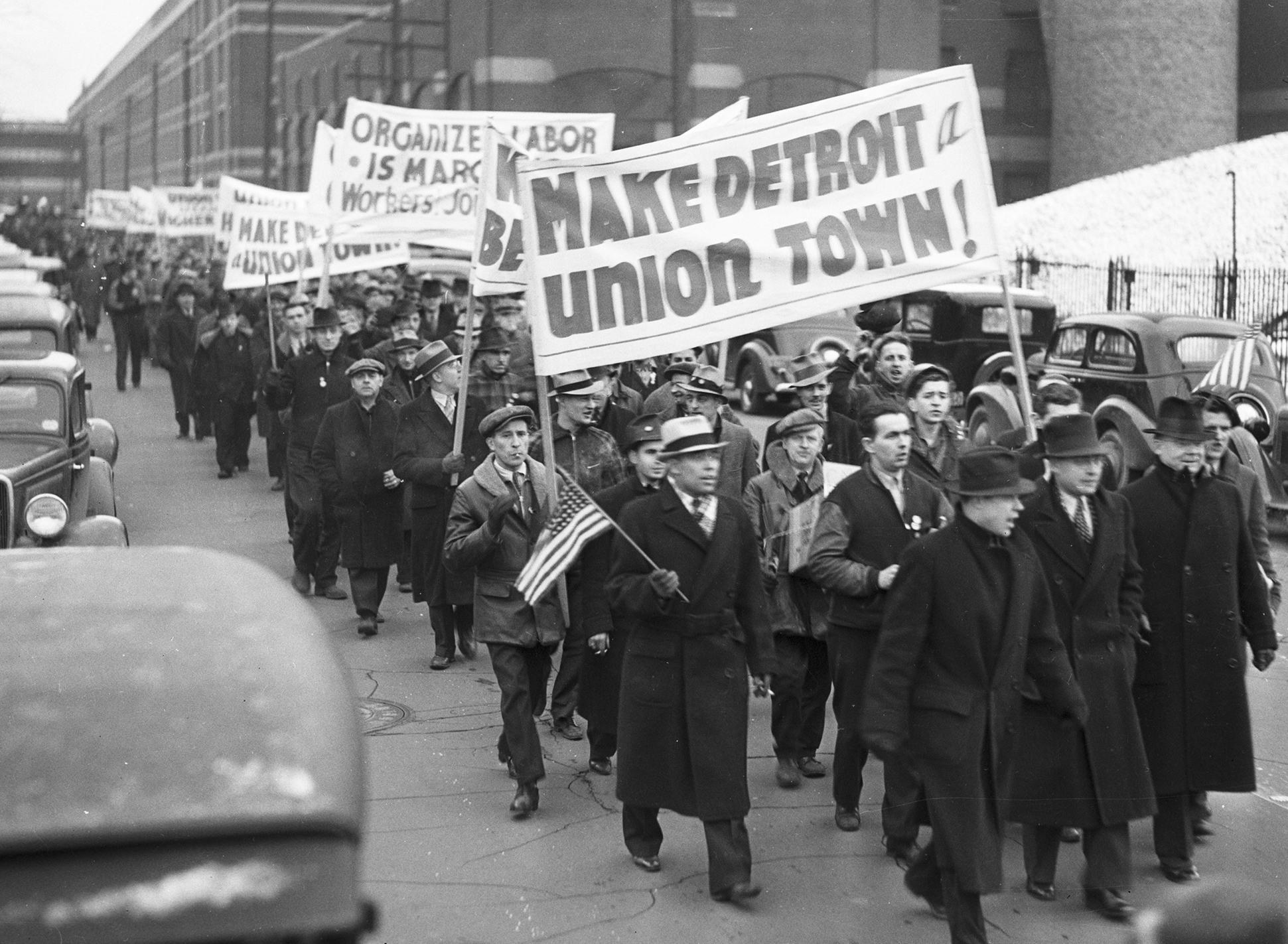
In 1915, General Motors purchased the Clark Street site from American Car and Foundry as part of its plans to expand its Cadillac division. Du Pont Engineering Company of Wilmington, Delaware oversaw the design and construction of GM’s Clark Street facility, which became known as one of the “most modern automobile complexes in the world.” Construction started in 1919, and the plant was fully operational by 1927.

The development of the Cadillac Clark Street plant coincided with GM President Alfred Sloan’s radical transformation of General Motors. In 1920, GM could claim only 12% of the auto market, while Ford led the industry with close to 60% of auto sales. Sloan assumed the role of company president in 1923; within six years, GM surpassed Ford as the industry’s sales leader. GM developed a car “for every purse and purpose,” while Ford, still intent on producing a low-cost vehicle, continued to focus on manufacturing the Model T. Meanwhile, GM redesigned each of its models annually, placing emphasis on styling and design to attract new customers. In the new GM order, Cadillac was the firm’s luxury flagship brand.
Clark Street’s manufacturing building produced both chassis and engines. Each Cadillac engine was tested for hours to ensure perfect operation. Located just 2.7 miles away, the Fisher Fleetwood plant built auto bodies and then shipped them to the Clark Street facility. At Clark Street, the bodies were hoisted up to the top floor where they were sandblasted, painted, and varnished before traveling downward for assembly. In the first floor Body Drop, the engine, chassis, and wheels were merged with the body to complete the car. In the tradition of Henry Leland, the celebrated head of Cadillac who left the company at the outbreak of World War I, the Clark Street plant combined engineering innovations with stylish designs. Production began with the chauffeur-driven LaSalle, styled by GM’s most celebrated auto designer, Harley J. Earl.
 1929
1929
By 1929, total sales for the Cadillac division stood at $5.6 million. During the 1920s and ‘30s, Cadillac introduced all-weather, closed-body cars, shatter-proof glass, designer-styled bodywork, all-steel roofs, and a V-type 16-cylinder engine that guaranteed a smooth ride. While using quality materials, management still worked to keep costs down. For example, GM introduced the new Phillips-head screw into Cadillac assembly lines in 1937, an innovation that sped up production through the use of power tools compatible with the bolt’s self-aligning, crosshead design.
With the onset of the Great Depression, Cadillac sales plummeted. GM executives questioned whether Cadillac should be discontinued, but the brand struggled on. By the end of the decade, Cadillac had pulled ahead of most of its competitors, but World War II put mass production of the brand on hold. Even before the war, Cadillac began producing parts for the Allison aircraft engine. The Clark Street plant also specialized in light tank production. The M-5 tank was the first combat vehicle with an automatic transmission. It had twin V8 engines and two Hydramatic transmissions connected through the gearbox. By the end of the war, Clark Street had produced 16,370 tanks (M-5, M-8 and M-24) and parts for 70,000 engines for P-38, P-39 and P-40 aircraft.
 10,000th M24 Chaffee Light Tank produced at Clark Street (1945)
10,000th M24 Chaffee Light Tank produced at Clark Street (1945)
Although Cadillac wasn’t producing luxury autos during the war, company ads still sought to reassure the public that it remained a brand synonymous with quality workmanship. Once the war ended, Cadillac was eager to resume luxury car production. Its 1948 model sported tail fins. The 1954 Cadillacs came equipped with power steering and automatic windshield wipers. Distinctive innovation continued: Cadillac introduced the first high-compression, overhead valve V-8 engines, was the first to offer a tilt and telescopic steering wheel, and it sold the first US-made cars with an electronic fuel injection system.
In November 1949, the millionth Cadillac, a 1950 Coupe de Ville, rolled off the assembly line. Production in both 1950 and ’51 topped 100,000 vehicles, reaching 192,000 in 1962. By 1968, the Clark Street plant had produced 200,000 Caddies and the workforce peaked at 12,000. However, Cadillac began to lose market share to luxury imports, especially BMW and Mercedes. Its answer was to introduce the Seville in 1975, marketing the new model as a lighter, sleeker, and easier-to-park Cadillac.
Although many considered the Clark Street plant to be at the height of modernity in the mid-1920s, the facility had become antiquated by the 1980s. This was particularly true for the paint department, thanks to new health and safety laws. Production lines were dependent on 18 freight elevators, not all of which worked on any given day. In 1985, General Motors moved operations to the one-story Detroit/Hamtramck assembly facility situated on 500 acres. In its last years, GM used Clark Street to produce the Oldsmobile 88, Custom Cruiser, Chevrolet Caprice and Impala, police cars, and taxicabs.
The last Fleetwood Brougham rolled off the Clark Street assembly line in December of 1987, but the parts operation continued. Plating was discontinued in March 1993 and the Engineering Office and tool room closed a year later. Before the buildings were demolished, the body drop section of the assembly line was moved to a special two-story wing of the Detroit Historical Museum, where it currently anchors the museum’s signature exhibit. In 1997, GM and three partners launched the effort to redevelop the site as the Clark Street Technology Park.
A CADILLAC CLARK STREET LABOR HISTORY MOMENT
On January 8, 1937, 300 workers at the Clark Street plant held a sit-down strike, just on the heels of a successful occupation at the nearby Kelsey-Hayes facility. This occupation was concurrent with the sit-downs at GM plants in Flint. By January 13 the strike included 112,000 of GM’s 150,000 production workers throughout the country. Aside from the Cadillac plant most of these were not plant occupations but picket lines.

Clark Street’s shop-floor activists consisted of skilled workers, ex-coal miners, and a handful of Communists and Socialists. One of the strikers later remarked that with only 300 sitting down, the police “could have wiped us out” if the city hadn’t been so pro-union. Four days later, another small group sat in at the GM Fleetwood plant. GM and UAW President Homer Martin met with newly elected Governor Frank Murphy on January 15. Murphy announced that GM management and union leadership had reached an agreement: sit-downers would leave five major plants over the weekend and negotiations would begin on Monday.
The next day, after discussion with Walter Reuther (he’s in the front row left in the above photograph), 208 Cadillac workers and 49 from Fleetwood marched out of their plants to the accompaniment of brass bands, under banners that read “We Have Just Begun to Fight!” and “Make Detroit a Union Town.” But within hours, the UAW realized that GM would not honor key elements of the agreement. So, the Union denounced the deal and continued to occupy other plants. GM attempted to reopen the Clark Street plant on January 25, but that effort was stopped by 3,000 picketers. The strike’s focus shifted to Flint where Walter Reuther’s, brothers Victor and Roy, Melvin Bishop and other UAW Westside Local #174 activists played prominent roles in the on-going sit-down that led to the historic February 11 contract settlement.
Click the links below to view:
Clark Street Cadillac: How an Automobile Plant Put Southwest Detroit on the American Map - “The Plant that Built America’s Luxury Automobile”, Matthew Harding’s research paper prepared for Dr. Tracy Neumann’s 2012 “History of Detroit” Wayne State University seminar.
America’s Motor City Exhibit, a description of the Detroit Historical Museum’s signature installation featuring the final section of the Clark Street Cadillac “body drop.” This Body Drop video demonstrates how the finished body was joined to the chassis near the end of the assembly line.
The Early Days of Cadillac Manufacturing and The Grand Old Man of Detroit, two articles from the MotorCities “Story of the Week” archives highlight Henry Leland’s impact on Cadillac and the industry, although Leland had left the company before this plant was constructed. The Guide’s Lincoln Motor Car Company page offers additional detail on his storied career.
Harley Earle, a profile from the Dyler.com Classic Cars listing service that offers insights into the career of the influential GM car designer responsible for so many of Cadillac’s iconic designs.
TEXT – DIANNE FEELEY / RESEARCH - DIANNE FEELEY & MATTHEW HARDING



